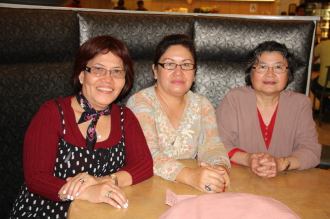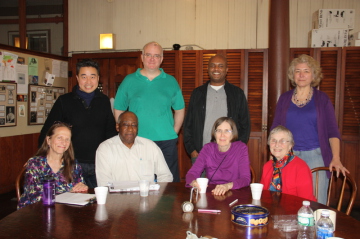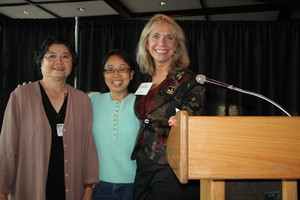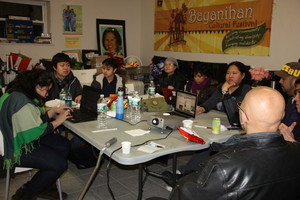Rural Health Nursing
Healthcare in the outlands: Administrators look for ways to attract RNs to rural health jobs
BY CATHRYN DOMROSE ON
Taylor Graham, BSN, RN, graduated from nursing school hoping to find a job in or around Boise, Idaho, the city of 200,000 where she’d grown up, or another urban center.
But when larger hospitals turned her down, she thought about Steele Memorial Medical Center in Salmon, a mountain community of some 3,000 people in the center of the state. She’d done a student clinical rotation there and had been impressed with the leadership, support for nursing and quality of care in the 18-bed critical access hospital.
The idea of rural nursing frightened Graham. She couldn’t imagine being the only RN on a unit, 300 miles away from the nearest larger hospital. But Steele Memorial administrators promised she would always have manageable patient loads, other RNs working with her, and a residency program that included training, sessions with a preceptor and meetings with nurses at other facilities who also were new to rural nursing. “I knew I was going to get the support that I needed and I was going to get the opportunity to learn,” she said. She decided to give it a chance. A year and a half later, Graham is still at Steele Memorial and in no hurry to leave.
Her experience represents the payoff some desperately short-staffed rural facilities hoped for about 10 years ago when they invested in ways to attract new nurses to remote areas where salary and benefits couldn’t compete with urban and suburban counterparts, and many new recruits didn’t stay through the first year. Administrators began looking for people who wanted to be in a rural community or who had ties to the community, and then supporting them so they would stay — a policy called “recruiting for retention.”
Despite sporadic shortages, healthcare organizations in many rural areas, like those in the rest of the country, have seen an ease in workforce issues as older nurses have put off retirement, said rural health researcher Susan M. Skillman, MS, deputy director at the University of Washington’s Center for Health Workforce Studies in Seattle. Nurses who couldn’t find work in urban areas often returned to their rural roots. Partnerships between universities, community colleges and rural facilities successfully produced more new nurses who wanted to stay put.
But recently, a number of areas are reporting increased difficulty finding RNs, say those who work with rural facilities. Healthcare facilities in central Washington, eastern Idaho, Wisconsin, Illinois and Montana report higher vacancy rates and more difficulty finding experienced nurses and new grads to fill positions, according to educators, administrators and regional association directors in those states.
Re-emerging shortage
“Of late the nursing shortage is hitting us again,” said Pat Schou, MS, RN, FACHE, executive director of the Illinois Critical Access Hospital Network, which has 53 member hospitals. Within the last six months — after several years of stability — hospital administrators are telling her they are having a hard time filling positions.
Facilities in rural Montana are in a similar situation, said Casey Blumenthal, DNP, MHSA, RN, CAE, vice president of the Montana Hospital Association. “In the last 13-1/2 years, I don’t remember such a universal cry for help.” The information is anecdotal and no one knows if the recent shortages are temporary fluctuations or portend a long-term situation. Workforce data show rural nurses typically are older than nurses in general. Retirement is a serious concern among rural facilities, said Pamela Stewart Fahs, PhD, RN, interim dean and professor at the Decker School of Nursing at Binghamton University in upstate New York, and editor-in-chief of Online Journal of Rural Nursing and Health Care. “I think we’re going to have a huge need again within the next five years.”
There are about 2,000 rural hospitals in the U.S., according to the American Hospital Association, including 1,328 critical access hospitals, which have fewer than 25 beds and are at least 35 miles away from another hospital. The facilities vary widely in patient population and staffing needs. “What’s rural in Montana is not necessarily what’s rural in Kentucky,” Fahs said. Shortages depend on how many nursing schools are in the region and whether area hospitals are primarily hiring bachelor’s-prepared nurses, she said.
They also may depend on the local economy. Though North Dakota is not facing an overall shortage of RNs, an oil boom in the western part of the state has created a huge demand for healthcare in some rural counties, said Patricia Moulton, PhD, executive director of the North Dakota Center for Nursing in Fargo, and president of the National Forum of State Nursing Workforce Centers. High-salaried jobs such as truck drivers are competing with healthcare facilities for workers, Moulton said. “All of that is impacting our supply.”
In parts of Montana, the oil boom has driven up the price of housing beyond the affordability of a nurse’s salary, Blumenthal said.
Federal workforce figures predict the country will have more than enough nurses by 2025 if demand and supply continue at the current pace. But many new graduates can’t or choose not to work in rural areas because of obligations such as a spouse who can’t find a job in a small community or a salary that won’t support a family. Others may be intimidated by the isolation of working in a small rural facility, or don’t want to drive long distances, sometimes in bad weather, say administrators and nurses who work with rural facilities.
Keeping nurses in the pipeline
Because a vacancy of even one or two people constitutes a shortage in a small staff, rural facilities must constantly think of new ways to keep nurses in the pipeline, said Cella Janisch-Hartline, BSN, RN, nursing leadership senior manager and coordinator of the residency program at the Rural Wisconsin Health Cooperative. “It’s always been an issue. We always have to be creative, coming up with new ways to entice people, to engage people, to attract people to our organizations.”
Evidence shows adequate pay and benefits are important in attracting and keeping nurses at rural facilities, Skillman said. Programs offering tuition reimbursement have successfully attracted new graduates to rural areas, “but they don’t stay very long,” said Angeline Bushy, PhD, RN, FAAN, professor and chairwoman of community health nursing at the University of Central Florida School of Nursing in Daytona Beach. Bushy has worked in a variety of rural health settings and researched and written extensively about rural nursing.
Though data is sparse, a number of studies have shown rural nurses with the highest job satisfaction rate prefer rural lifestyles and come from rural backgrounds. Some rural hospital administrators said nurses with ties to the community such as a spouse or parents in the area tend to stay longer than those without connections. Programs that recruit high school students to become certified nursing assistants, then connect them with distance learning programs to earn nursing degrees, have proven successful in many rural communities, Bushy said.
Though Graham did not grow up in a rural area, her grandparents live in Salmon and she was familiar with the community. An attraction for her was the residency program for new nurses offered by Steele Memorial, she said. She turned down offers from other rural hospitals that did not have residency programs. She and other residents — all new nurses at rural hospitals — met online regularly to talk about what was happening at work with their patients and colleagues. “It’s hard as a new nurse to talk about your problems when you don’t have a peer group,” Graham said, and those discussions, as well as support from a preceptor, helped her feel less isolated.
Some studies suggest RNs in rural areas are especially concerned about professional growth and continuing education, Skillman said. Some facilities have joined cooperatives that provide residency and training programs, or pay for training in specialties such as emergency medicine, trauma care and pediatrics. Some pay tuition or offer other support for education, encouraging nurses to get advanced degrees.
Small facilities need to figure out ways to keep nurses interested and active as their careers progress, Schou said. “Nurses like to be challenged.” She suggested moving nurses into leadership roles, working with community colleges to have them teach a class, or having them create community wellness programs. Online learning programs and access to specialists through telehealth can help nurses feel less professional isolation, Bushy said.
For all these things to work, rural facilities need leaders who recognize developing and keeping a strong nursing workforce is crucial to providing quality care, which will in turn attract more qualified nurses, Fahs said. But convincing harried nursing directors and stressed financial officers they need more resources to attract and develop new nurses isn’t always easy.
Partly because of a lack of solid data on what really works, and partly because resources at rural facilities tend to be scarce, few people seem to be doing much planning to address expected shortages as older nurses retire, said those who work with rural facilities. “They’ve had a tremendous culture shift lately,” Schou said, and are now dealing with the transition to electronic health records, population health, managed care, reducing readmissions and other changes as a result of healthcare reform. “They’re not doing a lot of planning” around workforce issues, Schou said.
Hurdles to reaching full staff
Even though a stable, satisfied and well-educated nursing staff would help them manage the challenges of healthcare reform, Skillman said, many healthcare administrators feel they can’t afford education and residency programs. “The money is tight and the shortages overall are not as great as they were back in the early 2000s.”
The leaders most open to evidence-based recruitment and retention strategies are those who have more education and involvement in promoting nursing as a profession, Janisch-Hartline said. Rural hospitals need to be training leaders to look at delivering healthcare from a global perspective, Blumenthal said. “How do we create organizations of excellence so nurses will want to come here?”
Even with its support and strong nursing leadership, Steele Memorial seems to be constantly looking for nurses, Graham said. The pay is not enough for some to support a family, and couples can’t always find work in the community for the non-nursing spouse. “It’s unfortunate because we have such a great program,” she said.
Her own experience has helped her grow personally and professionally in ways she never could have imagined happening in a more urban setting. She has worked with patients in labor and delivery, orthopedic, general surgery, and medical. She’s looking forward to receiving training in the ED. In part because of her intense work schedule, Graham found adapting to a different type of social life one of the most challenging aspects of rural nursing, but she’s now enjoying skiing on “perfect powder” snow, playing pool and helping ranchers chase down cattle.
“I had to reach pretty far out of my comfort zone,” she said, but the results have been worth it. “You have to be brave. You have to trust yourself a lot and have faith in your skills to do rural nursing.” •
Cathryn Domrose is a staff writer.
To comment, email editor@nurse.com.
Interesting links:
http://www.rrh.org.au/Articles/subviewnew.asp?ArticleID=1055
https://news.nurse.com/2016/01/18/healthcare-in-the-outlands-administrators-look-for-ways-to-attract-rn-to-rural-health-jobs/















































